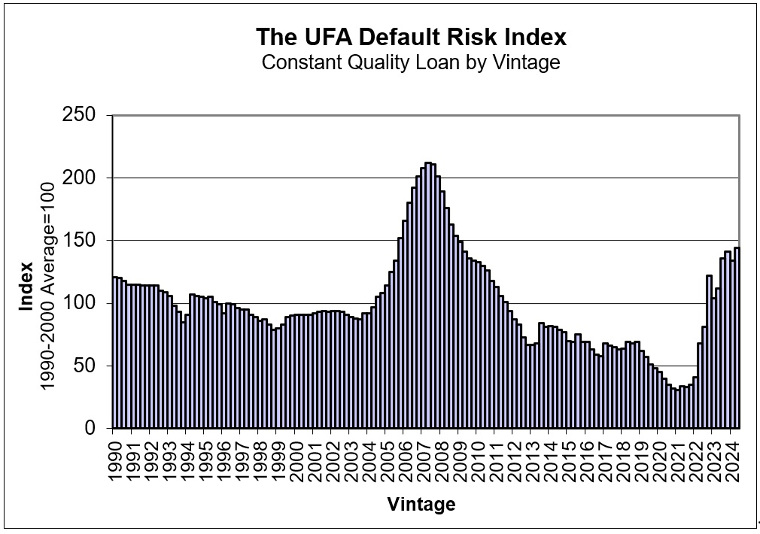
UFA Default Risk Index: "Higher for longer, higher for longer" ... Do we hear Powell now?
Spring 2024
The UFA Default Risk Index for the second quarter of 2024 has risen ten points from its first quarter 2024 level. The Index rose to 144 from last quarter’s revised 134 in our baseline scenario. Under current economic conditions, investors and lenders should expect defaults on loans currently being originated to be 44% higher than the average of similar loans originated in the 1990s, due solely to the local and national economic environment. That’s a key finding of the latest UFA Mortgage Report™ by University Financial Associates of Ann Arbor, Michigan.
“Historically, in inflationary periods (e.g., the early 1980s) the Fed has raised interest rates to restrictive levels, precipitating a recession that moderates inflation. In this cycle, metrics for monetary conditions relative to economic conditions, like the Taylor Rule, have never registered monetary policy as restrictive. Rather, monetary policy appears neutral relative to the Fed's mandate to maintain stable prices and jobs growth. Perhaps the current policy approach should be described as "Neutral for longer," because interest rates are only "neutral" relative to current economic conditions,” said Dennis Capozza, who is Professor Emeritus of Finance in the Ross School of Business at the University of Michigan, and a founding principal of UFA. “Our models are responding to the "Higher for longer" mantra. Our five-year real house price forecasts are more negative this quarter. Nominal five-year house price forecasts remain positive for most states and metros, despite negative real price growth in selected markets like the West Coast, Austin, Boise, and parts of Florida. With house prices elevated and mortgage rates in the 7% range, the percent of cash buyers is at historically high levels. The high cash flow cost of ownership makes mortgage borrowers more vulnerable to economic stresses like unemployment, divorce, or health issues. Mortgage originators and investors should exercise caution under these conditions, especially in the weaker locations.”
The UFA Default Risk Index measures the risk of default on newly originated mortgages. UFA’s analysis is based on a ‘constant-quality’ loan, that is, a loan with the same borrower, loan and collateral characteristics. The index reflects only the changes in current and expected future economic conditions, which are less favorable currently than in prior years.
Each quarter UFA evaluates economic conditions in the United States and assesses how these conditions will impact expected future defaults, prepayments, loss recoveries and loan values for nonprime loans. A number of factors affect the expected defaults on a constant-quality loan. Most important are worsening economic conditions. A recession causes an erosion of both borrower and collateral performance. Borrowers are more likely to be subjected to a financial shock such as unemployment, and if shocked, will be less able to withstand the shock. Fed easing of interest rates has the opposite effect.
UFA’s pioneering mortgage analysis has successfully predicted problems in the mortgage market well in advance including the increased defaults in Southern California in the mid-90s and the recent national mortgage crisis. Its predictions are based on an extensive analysis of local economic conditions in each state and the relationship of those conditions to loan performance. The historical record of millions of mortgage loans is studied each quarter to assess the vulnerability of each state to loan losses and prepayments. The detailed analysis of each state – including best and worst places to lend – is available in the UFA Mortgage Report, published on a quarterly basis.
